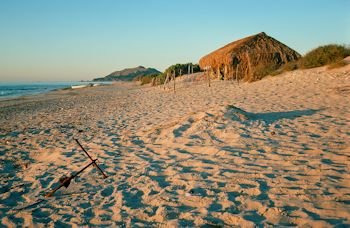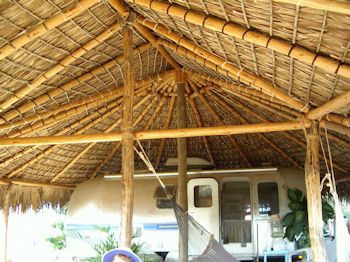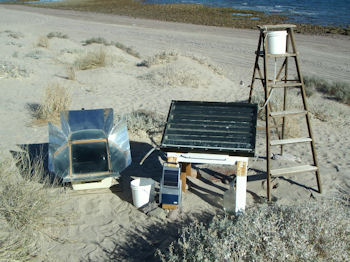 |  |
By Georgia Tanner

In the early 1990s I looked around my condo south of Rosarito Beach and realized I had everything I needed, and more. The "everything I needed" included city water, electricity from the local grid, a beautiful kitchen, a comfortable bed. The "and more" included mountain or sea views from every room, satellite TV, washer/dryer, microwave oven, dishwasher, forced-air heating, lawn, outdoor security lights to protect us residents and our stuff. But the lights disturbed my sleep and blotted out the stars, the lawn was only loved by the moles, the forced-air heating system once caught fire and filled the apartment with toxic smoke, and I didn't use the dishwasher. All those things came with the ecological cost of "embodied energy"--fossil fuel used in the extraction, manufacture, and transport of every product--and a big mortgage.
In 2002, after 911 and unexpected losses, I paid off the mortgage and went to live full-time in what had been a vacation place, a 30' trailer just steps from the Gulf of California, 49 kilometers south of San Felipe. Suddenly I was off the grid.
And yet I felt a deep and primary satisfaction. I had everything I needed, and more. The "needed" included a water tank, an RV toilet and septic system, a propane stove and refrigerator, a solar oven, a solar lantern, a solar distiller to make drinking water from the sea. The "and more" included a rowboat, a calendar to keep track of the northern Gulf's extreme tides, sunrise and moonrise over the sea, the sounds of birds and the occasional coyote concert, friends nearby, a sky full of stars, and space without barriers. Just like people before the invention of the light bulb, barely 100 years ago, I could walk by moonlight on the beach or in the desert.

I didn't miss TV or any of the condo's other "conveniences," and awareness of the increase in freedom, grew with every sunrise. I christened the old trailer: "The Most Exclusive Club in Baja." List of Exclusions: Electricity, TV, forced-air heating, dishwasher, microwave oven, phone, 24-hour security, 50-year bank trust, title insurance, CC&Rs, mortgage." The definition of "off the grid" is "not connected to the power lines, energy self-sufficient." If off-grid when the interconnected electricity grid goes down, as it did last year for much of Southern California and northern Baja, you still have power. And since such energy is decentralized, it's not a target for sabotage. You can be off the grid with all the electrical devices of a big suburban home, even air conditioning, provided you can afford the price of the solar array and/or generator required to run them and are not concerned about climate change or resource extraction (solar panels have an embodied-energy cost too). You can do it with a modest house and solar system, or decrease energy use all the way down to camping out. But in all the places I've lived off the grid--the eastern Sierras and Point Conception in California and the northern Gulf in Baja--nature was part and purpose of the lifestyle, which was closer to the wilderness-based life that humans have lived for 99 percent of our time on Earth.
The area where the old trailer was located was originally set up to provide off-road travelers with a seaside vacation base. Lots were leased, a small platform was built for a water tank, and a ramada (shed roof) was constructed to shade a trailer or motor home. Keeping it simple and mobile avoided worries of theft or damaging storms but did not provide much storage for supplies. As the beauty of the area became known, people wanted to stay longer or live there full-time, and thus more permanent structures were built. Now there are many big solar homes along that coast.

Another way to go that suits off-road situations and areas prone to hurricanes or chubascos (violent Gulf of California storms with hurricane-force winds) is to build a place like the one my boyfriend and I visited in 1976 at Cabo Pulmo on Baja Sur's East Cape. The owner had enlisted skillful Mexican locals to build him a small house made entirely out of woven palm fronds and posts from the mountains. White sand made up the floor and six door-size thatch panels lashed to the posts could be removed to open up the front of the house. Behind the house was a storm-proof storage shed, with a water tank on top, in which the generator, tools, and other supplies could be locked during the owner's absence. When a hurricane came through and destroyed the house, he had it rebuilt for less than $2000. Although coastal property in Baja has become more expensive, such a place might be built inland--a wise choice, considering sea level rise and stronger storms.
As for the logistics of change, those Gulf sunrises taught me that beauty counts, and that lifestyle change will be meaningful when it feels like an adventure.

Only place to get insurance 👍

Good service, good products...

Best insurance I've had so far